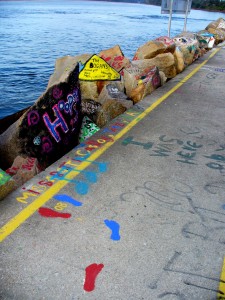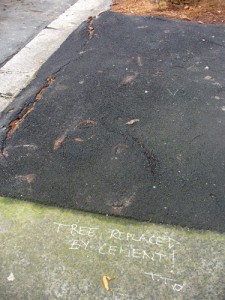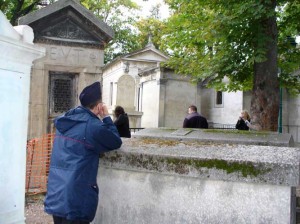Many thanks to friends, colleagues and total strangers who have shown interest and given support throughout the year.
And to those who have cricked necks after taking up a bit of pavement spotting yourselves …
HAPPY CRICKNESS !
Graffiti is usually spoken of as if it is an urban phenomenon, but of course people in non-urban areas do graffiti too. Often it is of the ‘I wuz here’ variety, some of which can be extremely elaborate. The graffiti on the Vee Wall at Nambucca Heads, painted by holidaying families, belongs to this category. But even this kind of folk-art graffiti is hated by people who dislike all graffiti on principle. They think it spoils the natural environment.
There are other people who use graffiti in campaigns to preserve the natural environment. For example, large messages painted on the road to Seal Rocks were made by locals protesting about a resort-style development proposed for the area.
 I have written about how people see things in different ways in an article called Perceptions – Graffiti Rocks  in Macquarie University’s Scan Magazine.
I have written about how people see things in different ways in an article called Perceptions – Graffiti Rocks  in Macquarie University’s Scan Magazine.
Hicks, M., 2010. Perceptions: Graffiti Rocks. Scan (Journal of media arts culture).
Â
 I am still thinking about why it is that some graffitists choose to write on the ground rather than on a wall or some other vertical surface. And that means I’m still thinking about graffiti that is site specific – where the message is relevant to that particular piece of pavement.
I am still thinking about why it is that some graffitists choose to write on the ground rather than on a wall or some other vertical surface. And that means I’m still thinking about graffiti that is site specific – where the message is relevant to that particular piece of pavement.
Here is a sad little piece of correction fluid graffiti. Gigantic Hills Fig trees are progressively being removed from this street in Enmore. Their roots break up the paving and are apparently playing havoc with people’s walls and sewer pipes. Perhaps they were an inappropriate choice for a street tree. But the street is looking bare without them and some of the residents – as well as all sorts of birds – are going to miss them. The loss of one of the trees is recorded in this tiny, signed epitaph: Tree replaced by cement! T.T.  10
There is more discussion and photographs of this tree and other trees in the same street on the Saving Our Trees website.
 Walls and other vertical surfaces are the usual choice of background for graffiti writers. So why do some people choose to write on the pavement? Maybe because it’s easy – no need to scale walls or climb ladders. Maybe because the pavement is relatively bare – there’s more asphalt and concrete available than empty walls. Maybe because property owners don’t dob you in if you write on the ground.
Walls and other vertical surfaces are the usual choice of background for graffiti writers. So why do some people choose to write on the pavement? Maybe because it’s easy – no need to scale walls or climb ladders. Maybe because the pavement is relatively bare – there’s more asphalt and concrete available than empty walls. Maybe because property owners don’t dob you in if you write on the ground.
All that is probably part of it, but there are other reasons as well. Many pavement inscriptions are site specific. Is this spot in Enmore a place where someone leaves bread for pigeons? If so, there’s not much point in leaving a polite little cardboard notice for them. Perhaps the glaring message Bread is making birds sick will have some effect in deterring them from polluting the street, attracting rats … and giving birds vitamin deficiency diseases.
The signs, symbols and graffiti on the ground are all evidence of a territorial battle that is being waged among government authorities, property owners, motorists, cyclists and pedestrians. Now the stencils themselves are getting in on the act. It is clear that this walker has cracked up and has said something sharp to the bicycle. But a zealous graffiti obliterator has painted over his speech balloon and now we’ll never know what it was he said.
These particular stencils are on a pathway in Cadigal Reserve in Summer Hill. The pathway continues along beside Hawthorne Canal, which eventually runs into an arm of Parramatta River.Â
The canal has a history of successive waves of pollution. Originally a stream called Long Cove Creek by early European settlers in Sydney, by the late 1800s it was fouled with house slops and the run-off from factories and slaughterhouses. The stink that it gave off was considered to be a health hazard and eventually it was excavated, re-aligned and lined with concrete in 1895 and renamed Hawthorne Canal.
But over the years the stormwater it collects has still been polluted with leaking sewage and dirt, horse manure, oil, chemicals, plastics, heavy metals and garbage washed off the roads and nearby rubbish dumps. And then, some time in 1990s, the canal was subjected to what some people regard as visual pollution – graffiti.
Taggers and graffiti artists continue to express themselves on the walls and under the bridges there. Their marks have spread to the pathway beside the canal. Government authorities and a bush regeneration group have done much to improve the banks of the canal in recent years, so it is understandable that they might want to remove ‘unsightly’ graffiti from the asphalt. They can’t win though. More pavement graffiti has appeared since the last applications of grey paint. But I wish I had been there before they covered up that pedestrian’s outburst.
(Some of the information for this post was obtained from Hawthorne Canal – the history of Long Cove Creek, written by Mark Sabolch and published by the Ashfield & District Historical Society in association with the Inner West Environmental Group in 2006)
This week’s post was written by guest spotter Julian Holland, who is a science curator and historian. Julian has been travelling recently in far western New South Wales.
Water – and there is a steady insistent drizzle as I write – water remains the central conundrum of the European experiment in settling Australia. Water is invisible in most of the Australian landscape most of the time. But sometimes – at rare intervals – it appears in abundance, even excess. Much of the drive for Australia’s exploration in the nineteenth century was the search for water – for an inland sea around which agriculture could develop and for navigable rivers which could transport people and produce to markets.
But the explorers’ quest gave way to the reality of Goyder’s Line, the boundary in South Australia beyond which rainfall could not be relied on for agriculture. The disjunction is marked on the landscape by a sudden shift in the character of vegetation.
Yet the myth of water remains powerful. In the old school house museum in Silverton, beyond Broken Hill, plastic stencils of different states reminded me of this. Apart from their boundaries – coast lines and surveyors’ lines – the only features they could guide a child’s pencil along were the courses of rivers and boundaries of lakes, patterning impressionable brains with the idea of water in the landscape.Â
The river that runs through Silverton, Umberumberka Creek, most of the time doesn’t run anywhere. It is a river of sand. It is characteristic of Australia’s dry land rivers, visible in the landscape as a ribbon of larger trees, their roots embracing the invisible river below the sand.Â
Instead of the ephemeral ripples of wind or insect or falling leaf – or the splash of oars – these rivers of sand carry slightly more enduring inscriptions.
Heading back to Broken Hill, on the outskirts of Silverton, the road bows down in courtesy to a passing creek – a feeder to the Umberumberka – dry too much of the time to warrant a bridge, the possibility of water, or the probability of its absence, marked by lines and depth measures of 0.50 and 1.00 metres. We inscribe the landscape and the landscape is inscribed in us. The two landscapes do not always match.
On the outskirts of the city proper, the Cimetière du Père-Lachaise is apparently the most visited cemetery in Paris. Amongst its crowded terraces of new and old graves lie the remains of many notable people. At the office visitors can help themselves to a free map of ‘sépultures parmi les plus demandées’ (some of the most asked-for graves).
Even though there are many examples of pavement graffiti in the gritty streets of the surrounding 20th arrondisement I did not find any in the cemetery itself. Nevertheless there is still much to interest the pavement and/or graffiti aficionado here, not least of which was a heavy duty manhole cover whose cast-iron pattern resembled the cobblestone pathway in which it was set.
Jim Morrison’s grave was not hard to find, with its gathering of sightseers paying homage behind a metal crowd barrier and a guard keeping a watchful eye on their behaviour. A nearby tree was covered in graffiti, some of it scraped into the trunk and roots, some of it written on the bark in felt-tipped pen.

Jim Morrison’s grave: the barrier, the guard, the tourists, the tree (the grave itself is out of sight in this picture)
On the other hand, the grave of artist Modigliani was more difficult to find, set back several rows from the intersection of two avenues in a Jewish part of the cemetery. Amedeo Modigliani’s art is characterised by beautiful figures with elongated faces and bodies. He was the archetypal bohemian, his dissolute way of life leading to an early death in 1920 at the age of 35.
At this site there was graffiti written on the gravestone itself, but just small inscriptions, most of them blurred by the weather and indecipherable – a tiny Modigliani-style face scratched into the stone, remnants of red writing, something in blue felt-tipped pen, another in white-out. I find it interesting that Modigliani still apparently engages young people – is it his art or his lifestyle?
 A short visit to Geneva reminded me that however high its standard of living, however conservative its ruling majority, however picturesque its heritage sites, and however manicured its parks, a city – being a place of people – inevitably has its scruffy side. Nor does graffiti occur only in the scruffy parts. Graffiti (including pavement graffiti) can undermine the intended mood of any place.
A short visit to Geneva reminded me that however high its standard of living, however conservative its ruling majority, however picturesque its heritage sites, and however manicured its parks, a city – being a place of people – inevitably has its scruffy side. Nor does graffiti occur only in the scruffy parts. Graffiti (including pavement graffiti) can undermine the intended mood of any place.
The International Monument to the Reformation is located in one of those manicured parks in the grounds of the University of Geneva. Unveiled in 1909, its statues and inscriptions honour the people and events of the 16th century Protestant Reformation, in which Switzerland had a central role. The central group of statues depicts Calvinism’s main proponents, William Farel, John Calvin, Theodore Beza and John Knox. And there, on the decorative paving at the foot of the wall I found two desperately heartfelt pieces of graffiti painted by Raf, who loves Romane F-K more than anyone.
Sometimes it’s a case of ‘you had to be there’. In several streets where I have walked, mainly in the 1st to 4th arrondissements, there are these large paintings on the pavement of a foetus, sometimes in the womb. They are not stencils but the uniformity of the different renditions and their size suggests that the act of painting them involved a performance calibrated to the artist’s body measurements. I could speculate about what event, cause or band they were advertising, but really I don’t know. I suppose the meaning of this graffiti was understandable at the time when it was done.
The foetus in Rue des Halles is an example of ‘layering’, where one piece of pavement graffiti is laid over another – in this case the ‘official graffiti’ of a pedestrian crossing. The photograph also shows a pair of police on roller blades.